Key takeaways:
- Sustainable food sourcing emphasizes environmentally friendly, socially equitable, and economically viable practices throughout the food supply chain.
- Local sourcing fosters community bonds, supports food security, and can enhance local economies while promoting environmental preservation.
- Challenges include higher costs, inconsistent availability of seasonal produce, and a lack of consumer education about sustainable practices.
- Engaging with local farmers, prioritizing seasonal produce, and exploring plant-based meals are effective strategies for sustainable food sourcing.
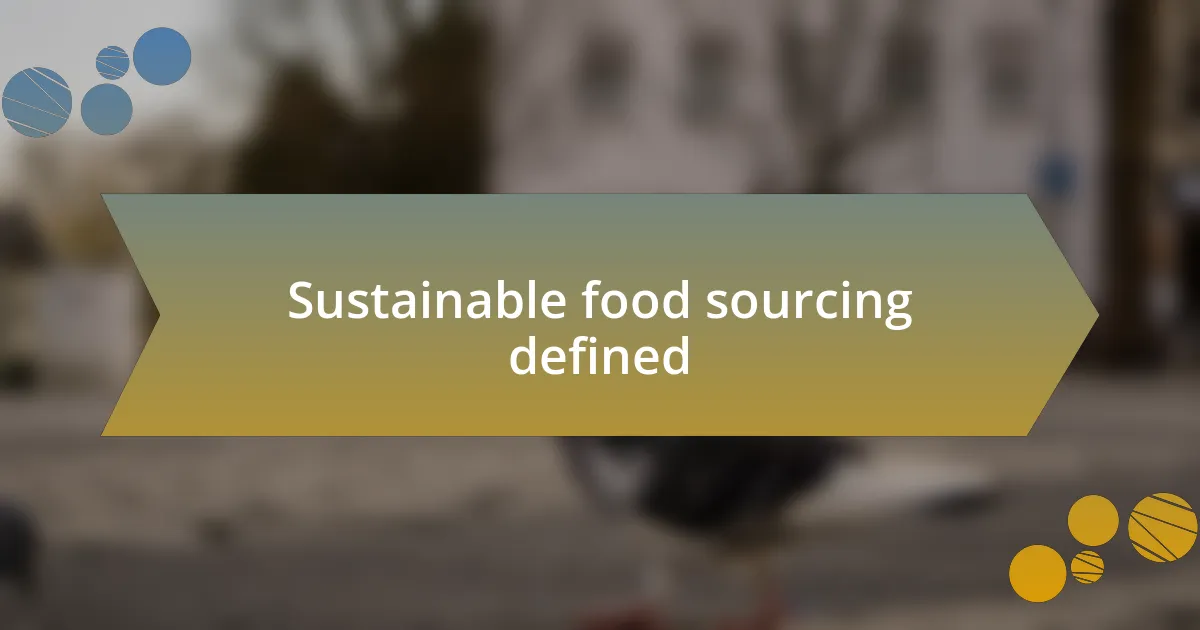
Sustainable food sourcing defined
Sustainable food sourcing refers to the practice of obtaining food in a way that is environmentally friendly, socially equitable, and economically viable. It involves considering the entire food supply chain, from how food is produced and transported to how it is disposed of. I remember visiting a local farmers market and feeling a sense of connection to the land and the community; it made me realize how our food choices can impact not just our health but also the planet’s well-being.
The concept goes beyond mere organic farming; it encompasses practices such as regenerative agriculture, agroforestry, and permaculture, which all aim to enhance biodiversity and minimize ecological footprints. Have you ever thought about where your food comes from? That moment of reflection can inspire a shift towards sourcing food that does not just nourish our bodies but also supports sustainable ecosystems.
For me, sustainable food sourcing means choosing local ingredients that reflect the seasons and cultural heritage of a region. By nurturing these connections, we can create a food system that respects nature and the people who rely on it for their livelihoods. When I opt for these practices, I feel a profound sense of responsibility and hope for a brighter future—not just for myself, but for generations to come.
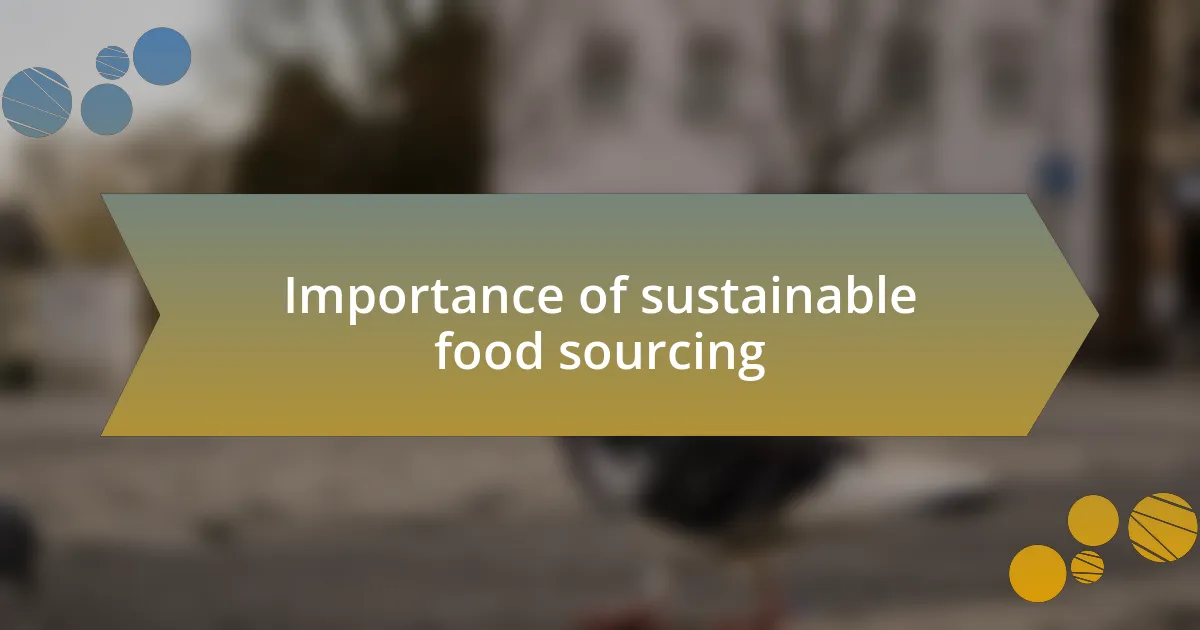
Importance of sustainable food sourcing
Sustainable food sourcing plays a crucial role in preserving the planet’s health and resources. I often reflect on my experiences in community gardens, where I witnessed firsthand how local sourcing strengthens bonds among neighbors while promoting healthy eating patterns. Isn’t it empowering to know that the choices we make at the grocery store or market can lead to cleaner air, soil, and water?
Moreover, sustainable practices are vital for ensuring food security and resilience in the face of climate change. For instance, I recall attending a workshop on regenerative agriculture, where farmers shared their stories of restoring degraded lands. Their pride in improving both the soil quality and their yields was palpable. Are we fully aware of the positive ripple effects our food sourcing decisions can have on future generations?
Lastly, embracing sustainable food sourcing can foster economic opportunities for local communities. When we prioritize local farmers and businesses, we contribute directly to our economy and create jobs. I vividly remember my first visit to a community-supported agriculture (CSA) program; the excitement of selecting fresh, organic produce made the connection between my choices and their impact on local livelihoods incredibly real. Isn’t it fulfilling to feel that by supporting sustainable food sourcing, we are investing in the well-being of our communities?

Overview of sustainable projects
Sustainable projects encompass a wide range of initiatives designed to reduce our environmental footprint while enhancing community welfare. I find it fascinating how these projects often bring together diverse groups of people united by a common goal of creating a healthier planet. Have you ever participated in a local cleanup or community garden? The camaraderie felt during these gatherings is often uplifting and reinforces our collective responsibility toward sustainability.
One of the most inspiring aspects of sustainable projects is their innovative approach to solving global challenges, like climate change and food insecurity. I remember attending a seminar where a young entrepreneur showcased how urban farming was transforming vacant lots into vibrant sources of fresh produce. It made me realize how even small-scale initiatives can have significant impacts on our cities. Isn’t it incredible how creativity can unlock solutions we never thought possible?
Additionally, collaboration is a key element in the success of sustainable projects. From local governments to non-profit organizations and businesses, I’ve seen firsthand how partnerships can amplify their effectiveness. During a recent workshop, I was struck by how different sectors could align their efforts to promote sustainability, making lasting changes. It begs the question: what role can each of us play in supporting these collaborations?
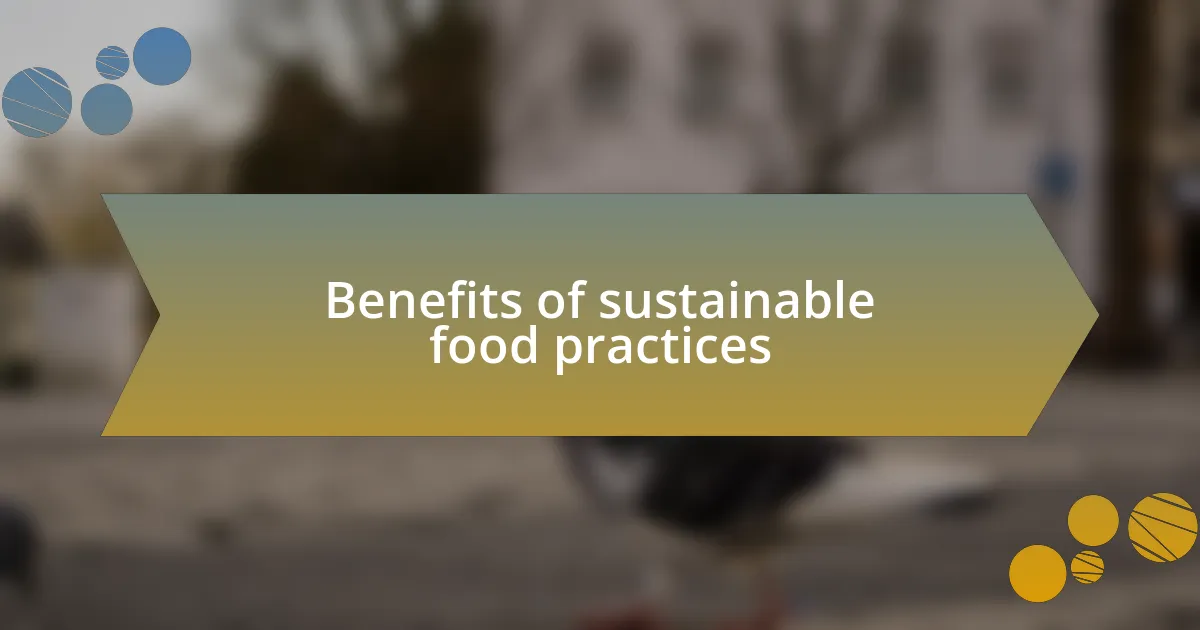
Benefits of sustainable food practices
When I think about the benefits of sustainable food practices, the first thing that comes to mind is the incredible boost to local economies. Supporting local farmers not only provides fresh produce but also keeps money within the community. I vividly recall visiting a farmers’ market one weekend and interacting with the vendors; their passion for what they do was palpable. Doesn’t it just feel right to support someone whose hard work directly nourishes your community?
Moreover, sustainable food sourcing contributes significantly to environmental preservation. By opting for organic or local products, we reduce our carbon footprint since food travels shorter distances. I once switched to a local CSA (Community Supported Agriculture) box, and not only did I receive vibrant, seasonal produce, but I also felt a deep connection to the land. Isn’t it empowering to know that our choices can positively impact our planet?
In addition to economic and environmental benefits, sustainable food practices can enhance our health. Fresh, minimally processed foods are packed with nutrients, and embracing seasonal eating has helped me discover new flavors and recipes. I remember the first time I tried a dish made with freshly harvested greens; the taste was astonishingly vibrant. Have you ever felt that rush of satisfaction from knowing you’re fueling your body with the best nature has to offer?
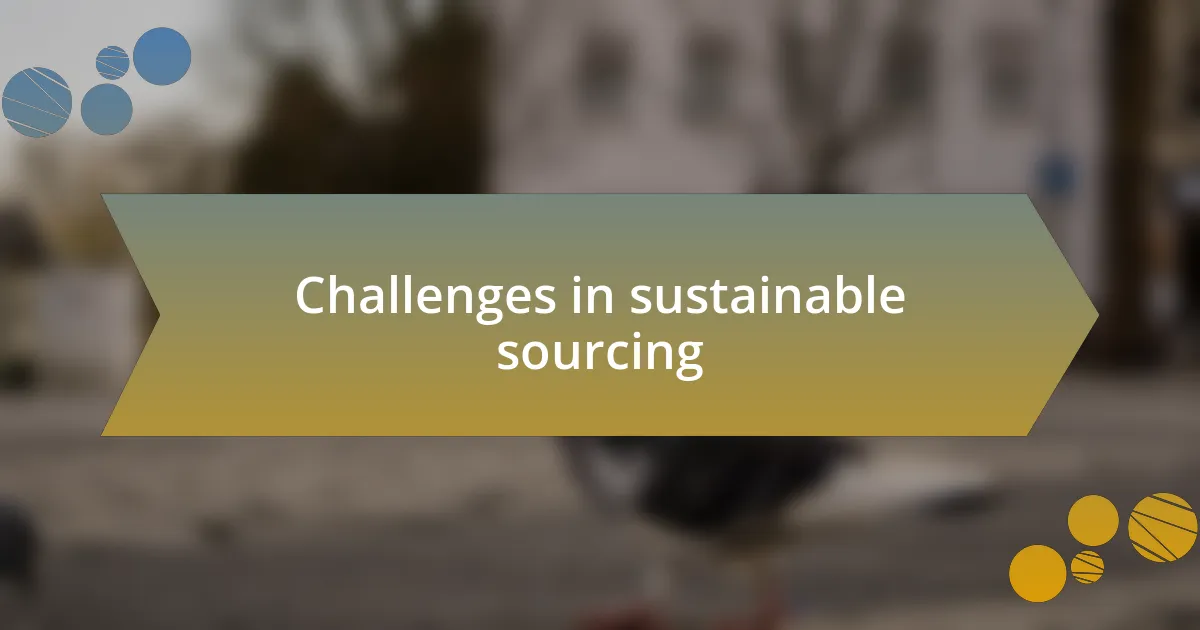
Challenges in sustainable sourcing
Sustainable sourcing faces several challenges, primarily related to cost. When I first explored local food options, I was surprised by the price difference compared to conventional products. Have you ever considered how the initial expense might deter consumers from making eco-friendly choices? It’s tough, especially when budgets are tight.
Another hurdle is the inconsistent availability of seasonal produce. I remember eagerly anticipating the arrival of heirloom tomatoes only to be disappointed when they didn’t show up at the farmer’s market. This unpredictability can frustrate both consumers and chefs alike, as sourcing fresh ingredients that align with sustainable practices can be far from straightforward.
Lastly, there’s the issue of consumer awareness and education. Many people simply aren’t informed about the benefits of sustainable sourcing. I recall a conversation with a friend who was unaware that certain practices affect not just the environment but also their health. Isn’t it interesting how a little education can shift perspectives and motivate change? Engaging consumers is crucial in overcoming this challenge.
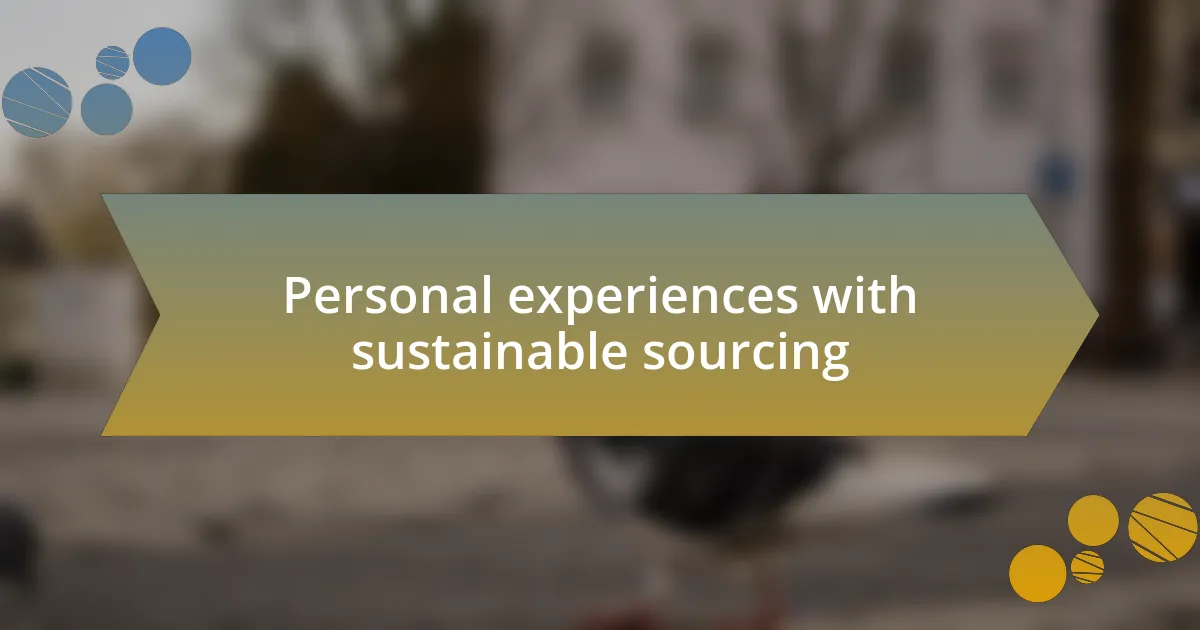
Personal experiences with sustainable sourcing
My journey with sustainable sourcing began when I joined a community-supported agriculture (CSA) program. The first time I attended a farm-to-table dinner hosted by the CSA, I felt a profound connection to the food I was eating. Have you ever tasted a carrot straight from the soil? That burst of flavor was far superior to anything I had previously experienced from a grocery store. It showed me just how rewarding it can be to support local farmers while enjoying fresh, delicious produce.
I also remember the first time I made the leap to a zero-waste grocery store. While it was a bit overwhelming at first—who knew there were so many types of bulk grains?—the feeling of ditching single-use plastic was exhilarating. It was as if I was part of a larger movement, working not only for myself but for the planet. It made me wonder how many others are hesitant to take that step due to fear of the unknown.
One particularly impactful experience was when I volunteered at a local food bank that prioritized sourcing from sustainable producers. I was genuinely moved by the stories shared by food recipients who were grateful for fresh, nutritious options. It struck me how vital it is to marry sustainability with accessibility. Do we not all deserve healthy food, regardless of our circumstances? This experience solidified my belief that sustainable sourcing must also consider social equity.
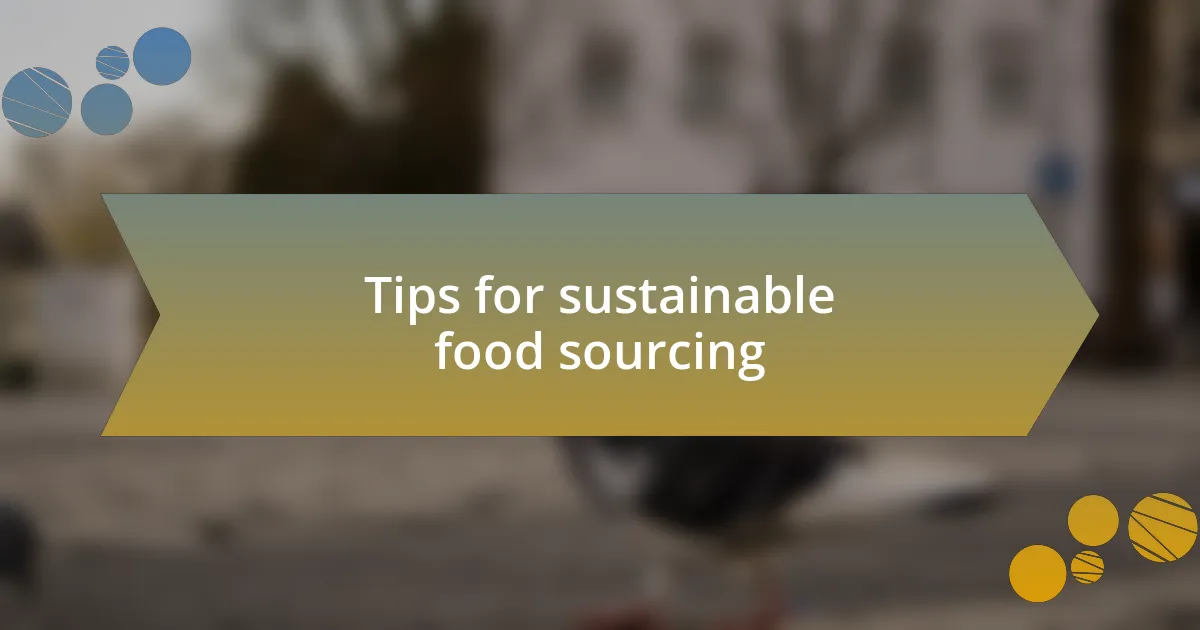
Tips for sustainable food sourcing
When considering sustainable food sourcing, one of the best practices is to prioritize seasonal and local produce. I remember walking through a farmers’ market in the fall, enchanted by the vibrant colors of seasonal fruits and vegetables. Buying local not only supports farmers in your community but also reduces the carbon footprint associated with transporting food over long distances. Have you ever thought about how your food traveled to your plate?
Another excellent tip is to embrace plant-based meals. After experimenting with meatless Mondays, I was amazed at how delicious and fulfilling a well-prepared vegetable stir-fry could be. This shift not only lessened my environmental impact but also opened up a world of flavors I had overlooked. Can you imagine the potential for creativity in your cooking by exploring plant-based recipes?
Lastly, don’t shy away from getting to know the producers behind your food. I once met a farmer who shared their challenges and triumphs in growing organic vegetables—what a revelation! It deepened my appreciation for the food I consume and led me to advocate for transparency in the food system. How often do we pause to think about the stories our food has to tell? By building these connections, we can forge a meaningful relationship with the sources of our sustenance.